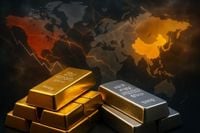October 2025 will be remembered as a month when the global metals market was thrown into sharp relief by a dizzying mix of geopolitical drama, trade tensions, and a scramble for resources. As traditional safe havens like gold and silver shattered record highs, industrial metals such as copper and aluminum faced their own seismic shifts, shaped by tightening supply chains and a new push for sustainability. The twin stories of surging prices and strategic maneuvering reveal a world wrestling with uncertainty—and a metals market at the very heart of the storm.
On October 20, 2025, Hong Kong Exchanges and Clearing (HKEx), the parent company of the London Metal Exchange, announced the launch of Commodity Pricing and Analysis Ltd (CPAL), a Dubai-based pricing agency designed to set green metal price premiums. According to reporting by MarketMinute, CPAL will use trusted sourcing data and Metalshub’s trading records to challenge the dominance of established players like Fastmarkets and S&P Global Platts. This move comes at a time when the supply chains for metals such as copper and aluminum are under intense strain, mostly due to new Chinese export rules and raw material curbs that are driving up prices and making sourcing more complex.
Metalshub, already a significant player, moved over $220 million in refined nickel last year, including 488 tons of low-carbon nickel since March 2025. If the momentum continues, copper and aluminum could soon join the ranks of metals with established green premiums, further reshaping how these commodities are traded and valued.
But the story doesn’t end at the industrial level. The ripple effects of these disruptions have been felt throughout the global economy, nowhere more dramatically than in the precious metals market. As reported by MarketMinute on October 20, 2025, both gold and silver soared to record highs this month. Gold topped $4,300 per ounce, with a peak of $4,378.69 on October 17, while silver’s spot price hit a new all-time high of $52 per ounce, marking a staggering 60% rally since April.
This rally is no accident. Investors, facing a landscape riddled with uncertainty, have flocked to safe-haven assets. The US-China relationship remains a perennial source of volatility, and this month saw a fresh escalation. On October 9, China imposed new export controls on rare earth materials, production equipment, and lithium-ion batteries, while also sanctioning US subsidiaries of a South Korean shipbuilding firm and increasing port fees for US vessels. These measures were widely interpreted as retaliation for recent US trade blacklists targeting key Chinese industries.
The very next day, President Trump responded by threatening "massive" and "additional 100%" tariffs on all Chinese goods, set to take effect on November 1. Markets reeled at the prospect, but a glimmer of hope emerged by mid-October when President Trump conceded that a 100% tariff would not be "sustainable." This paved the way for a major announcement: a new round of high-level trade negotiations in Malaysia between US Treasury Secretary Scott Bessent and Chinese Vice Premier He Lifeng, with both sides eager to find common ground, at least in the short term.
Yet the underlying tensions remain. US restrictions on technology exports to China persist, driven by concerns over intellectual property and competition for critical resources. These are not mere headline risks—they have real, tangible impacts on companies and consumers worldwide. Major tech firms like Apple, NVIDIA, and Qualcomm, all of whom rely on complex global supply chains and Chinese manufacturing, face mounting challenges from tariffs and potential supply disruptions. As the article in MarketMinute notes, "companies like Apple... could see their profitability squeezed by tariffs and reduced demand in a strained economic environment."
The industrial metals market is feeling the heat as well. At the October 2025 London Metal Exchange seminar, experts predicted copper demand would rise 24% by 2035, thanks to booming sectors like artificial intelligence and electric vehicles. But supply is not keeping pace. Europe’s copper premiums for 2026 contracts have soared to all-time highs—$325 and $315 per ton, set by Codelco and Aurubis, respectively—amid tariffs and shaky supply. Aluminum, too, is on a tear, with prices expected to break through $3,000 per ton if Chinese production caps persist. Even Australia has felt the pinch, pledging A$135 million to keep its smelters afloat as costs rise.
China’s tightening grip on critical minerals, including rare earths, has only compounded the problem. By adding more rare earths to export restrictions, China has made sourcing these materials even more challenging for global buyers. The result? Decade-high prices and an urgent need for new strategies among governments and businesses alike.
Meanwhile, the broader geopolitical backdrop has only heightened investor anxiety. The ongoing Russia-Ukraine war and the Israel-Hamas conflict continue to fuel regional instability, raising concerns about energy and food security and contributing to stubbornly high inflation rates. Domestic political turmoil in France and Japan, as well as a US government shutdown, have added to the sense of unease. Recent disclosures of loan irregularities linked to potential fraud in two US regional lenders have further shaken confidence in the financial system.
In this environment, central banks have been quietly but steadily diversifying their reserves away from the US dollar—a trend known as de-dollarization. This has provided structural support for gold and silver prices, reinforcing their status as the ultimate stores of value in turbulent times. The MarketMinute report highlights this "tectonic shift," noting that central banks are actively increasing their gold allocations, a clear sign of institutional belief in the enduring value of precious metals.
For companies in the mining sector, particularly those focused on gold and silver, the current climate has been a windfall. Giants like Barrick Gold and Newmont are enjoying surging revenues and the prospect of higher profit margins, while smaller, junior miners with promising deposits are attracting new investment. On the flip side, manufacturers and other companies reliant on stable global trade are grappling with higher input costs and the risk of supply chain breakdowns.
Looking ahead, the trajectory of both precious and industrial metals will depend heavily on the evolution of US-China relations and the broader geopolitical landscape. Any breakthrough in trade talks could trigger profit-taking in gold and silver, as seen with gold's brief dip after President Trump's softened rhetoric. But the underlying drivers—persistent inflation, robust central bank demand, and pervasive geopolitical risk—are unlikely to fade anytime soon.
For now, the metals market stands as a microcosm of the wider world: volatile, unpredictable, and shaped by forces that defy easy solutions. Whether you’re a miner, a manufacturer, or a cautious investor, the only certainty is that the race to secure reliable metal supplies—and the search for safe havens—will remain at the top of the global agenda.




